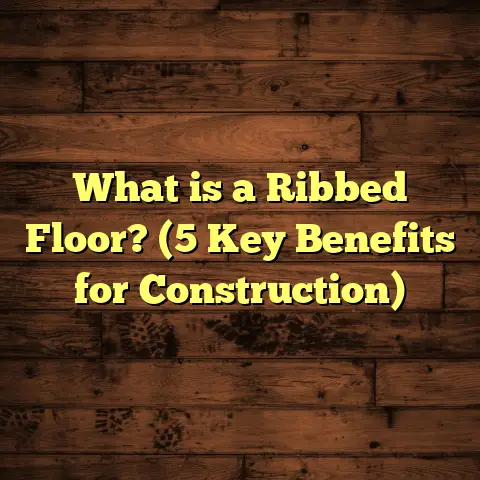What is Brazilian Koa Hardwood Flooring? (5 Benefits You Must Know)
How do you pick a hardwood floor that’s not just beautiful but tough enough to last for decades? If you’re exploring exotic woods, you might have stumbled on Brazilian Koa hardwood flooring. I remember my first encounter with this wood—it wasn’t just about the look; it was about how it performed in real-life conditions. Over years working with various hardwoods, Brazilian Koa has become one of my favorites. I want to share everything I’ve learned—from what it actually is, to how it behaves, and why it might be perfect for your home.
What Is Brazilian Koa Hardwood Flooring?
Brazilian Koa hardwood flooring comes from a tree species native to Brazil and parts of South America. It’s part of the Astronium genus, often called Muiracatiara or Tigerwood because of its distinctive striped grain patterns that resemble tiger stripes. Though it shares the “Koa” name with Hawaiian Koa, these are different species with unique characteristics.
Brazilian Koa is prized for its striking visual texture—deep reddish-browns interspersed with golden and black streaks create a dramatic floor surface. What makes it stand out beyond aesthetics is its toughness. It ranks about 2,300 on the Janka hardness scale, which tells you how resistant a wood is to dents and wear. To put that in perspective, red oak—a common hardwood—is about 1,290 on this scale, so Brazilian Koa is nearly twice as hard.
This hardness means floors made from Brazilian Koa resist scratches and dings better than many domestic woods. When I first installed it in a client’s high-traffic home, I noticed how much less wear it showed after months compared to other woods I’d worked with.
Brazilian Koa is available as solid hardwood planks or engineered wood. Engineered Brazilian Koa consists of a thin layer of Brazilian Koa veneer glued over plywood or high-density fiberboard. This construction helps stabilize the wood against moisture—something very useful in humid climates or over concrete slabs.
The wood contains natural oils that help protect it from insects and moisture damage, which adds to its longevity. It also has a relatively straight grain with occasional waviness or curls, enhancing its unique look.
My Journey Discovering Brazilian Koa Flooring
When I started flooring professionally, I mainly worked with familiar domestic woods like oak and maple. They were reliable but lacked the exotic flair some clients wanted. One day, a client asked if I could install something unique—something that would ‘wow’ visitors but still hold up under everyday use.
That’s when I explored Brazilian Koa. My first project was a coastal home where humidity was a constant challenge. I installed engineered Brazilian Koa with an oil-based finish. Not only did the floor look stunning with its rich color shifts, but it held up beautifully without warping or cupping.
Over time, I gathered more experience with this wood in different environments—from sunny living rooms to busy kitchens. Each time, it proved its worth by combining elegance with durability. That’s why I keep recommending it to clients looking for an exotic hardwood that’s practical too.
The 5 Benefits of Brazilian Koa Hardwood Flooring You Should Know
1. Exceptional Durability and Hardness
One standout feature for me is how tough Brazilian Koa is. Its Janka rating of 2,300 means it resists dents and scratches better than many popular hardwoods. For people with kids or pets, this translates to floors that stay beautiful longer.
In one project involving a family with two energetic dogs and young children, the homeowner was amazed at how well the floor held up after a year filled with rough play and heavy foot traffic. The floor had barely any scratches or marks.
This hardness also makes Brazilian Koa ideal for commercial spaces like cafes or boutiques where durability is critical.
2. Unique and Striking Aesthetic Appeal
Brazilian Koa’s grain pattern and color variation make each plank a piece of art. The wood’s natural contrast between dark stripes and lighter areas offers a floor that is dynamic and full of character.
I installed it in a modern home recently where the homeowners wanted an eye-catching floor that would serve as a centerpiece. The color tones ranged from warm golds to deep reds with black streaks weaving through. The sunlight dancing across the floor really brought out its depth.
If you like floors that tell a story and add personality to rooms, Brazilian Koa delivers beautifully.
3. Natural Resistance to Moisture and Insects
Many hardwoods can warp or swell when exposed to moisture over time, but Brazilian Koa performs better thanks to natural oils in its fibers. This makes it less prone to cupping or shrinking in humid environments.
I recall working in a beach house where salt air and humidity were constant concerns. Other floors previously installed had bowed or lifted in spots after just a few months—but the Brazilian Koa floor stayed flat and solid.
Its insect resistance also means fewer worries about termites or wood-boring pests damaging your investment.
4. Flexibility in Installation Methods and Finishes
You can find Brazilian Koa as both solid boards and engineered planks. Solid planks work well for traditional nail-down installations over wooden subfloors. Engineered planks are better suited for glue-down applications on concrete or floating floors using click-lock systems.
This flexibility means you can use Brazilian Koa in almost any room or building type.
Finishing options vary from satin matte to glossy polyurethane coatings or penetrating oil finishes that deepen the wood’s natural color and highlight grain texture. I’ve found oil finishes particularly useful for high-traffic homes because they’re easier to spot-repair without refinishing entire rooms.
5. Long-Term Cost Efficiency and Environmental Benefits
Though Brazilian Koa can cost more upfront than domestic woods—typically $7 to $12 per square foot for materials—the durability reduces maintenance costs over time.
In my projects, clients have saved money by avoiding frequent repairs or early floor replacements.
Additionally, many Brazilian Koa suppliers follow sustainable forestry practices certified by organizations like the Forest Stewardship Council (FSC). This means the wood comes from responsibly managed forests, which is a bonus if you want an eco-friendly option.
Detailed Data and Technical Insights
- Janka Hardness: Approximately 2,300 (compared to red oak at 1,290; hickory at 1,820).
- Density: Around 850 kg/m³ (heavier than many domestic hardwoods).
- Modulus of Elasticity: High stiffness value (~16 GPa), meaning it resists bending well.
- Dimensional Stability: Less than 8% dimensional change under varying humidity.
- Natural Oils Content: Provides resistance to rot and insect damage.
- Typical Board Widths: 3 to 5 inches.
- Thickness: 3/4 inch for solid; 3/8 to 1/2 inch for engineered.
- Sustainability: Many suppliers comply with FSC standards ensuring legal and ethical harvesting.
These numbers reflect why Brazilian Koa combines beauty with real-world performance so effectively.
How FloorTally Helps Me Nail Cost Estimations
One challenge with exotic hardwoods like Brazilian Koa is pricing varies widely depending on location, supplier, finish choice, and installation method. That’s why I use FloorTally for cost estimates—it consolidates local material prices, labor rates, and waste factors into one easy interface.
For instance, when bidding on a large renovation featuring Brazilian Koa in multiple rooms, FloorTally helped me quickly calculate total material needs including about 10% extra for cutting waste. It also factored labor costs based on my region’s going rates.
This tool saves hours of back-and-forth getting quotes and helps me give clients realistic budgets upfront so there are no surprises later.
My Installation Tips You’ll Appreciate
Brazilian Koa can be installed by nailing, gluing, or floating depending on plank type and site conditions:
- Nail-down works well for solid planks over wooden subfloors.
- Glue-down is common for engineered planks on concrete slabs.
- Floating installation suits engineered click-lock planks for DIY projects.
Because Brazilian Koa is dense and hard, pre-drilling nail holes reduces splitting risks during installation. Also, acclimating the wood inside your home for at least 72 hours before installation minimizes expansion or contraction issues afterward.
If you want a natural look that highlights grain texture, consider oil-based finishes instead of polyurethane; however, note they require more upkeep over time.
Maintenance Advice That Keeps Floors Beautiful
Brazilian Koa is tough but still benefits from some care:
- Sweep or vacuum regularly to remove dirt that can scratch the surface.
- Use damp mops with pH-neutral cleaners designed for hardwood floors.
- Avoid excessive water or harsh chemicals that strip protective oils.
- Place felt pads under furniture legs to prevent dents.
- Schedule refinishing every 7–10 years depending on wear patterns.
Following these simple steps extends your floor’s life while maintaining its shine.
Case Study: Coastal Florida Home Success Story
A client near Miami wanted an exotic yet durable floor that could withstand salty air and high humidity without warping or fading. We chose engineered Brazilian Koa finished with a matte water-resistant coating.
After two years of heavy use—kids running around, beach gear tracked inside—the floor remained flawless with no cupping or discoloration.
The homeowner said it felt like walking on art every day—a perfect fusion of function and style.
Comparing Brazilian Koa With Other Exotic Hardwoods
It helps to compare Brazilian Koa against other popular exotic hardwoods:
| Wood Type | Janka Hardness | Color Range | Moisture Resistance | Cost per Sq Ft (Material) |
|---|---|---|---|---|
| Brazilian Koa | ~2,300 | Golden brown to red/black stripes | High | $7–$12 |
| Brazilian Cherry | ~2,350 | Rich reddish brown | Moderate | $6–$10 |
| Tigerwood (Other) | ~2,200 | Orange-red with dark stripes | High | $7–$11 |
| Mahogany | ~1,100 | Deep reddish brown | Moderate | $8–$14 |
Brazilian Koa’s combination of hardness plus moisture resistance makes it stand out among these choices—especially if you want something both tough and visually striking.
Can You Use Brazilian Koa Outdoors?
While Brazilian Koa is naturally oily and resistant to insects, using it outdoors requires extra care. It’s best suited for covered porches or patios where direct exposure to rain is limited.
Applying marine-grade finishes greatly improves weather resistance if installed outdoors but expect regular maintenance due to sun exposure fading colors over time.
What About Allergies and Indoor Air Quality?
Brazilian Koa contains natural oils but generally doesn’t emit strong odors after finishing. Using low-VOC finishes keeps indoor air quality healthy—a priority I always discuss with clients sensitive to allergens.
DIY vs Professional Installation: What Works Best?
If you’re thinking about installing Brazilian Koa yourself:
- Engineered click-lock planks are doable for experienced DIYers.
- Solid planks usually require professional tools and skills—especially nail-down methods.
- Proper acclimation plus moisture testing subfloors are crucial steps not to skip.
If you’re unsure about subfloor condition or installation method suitability, calling in a pro saves headaches down the road.
More Personal Stories From My Flooring Projects
In one historic home renovation I worked on, we replaced worn-out pine floors with solid Brazilian Koa. The client wanted something that would stand out but still feel warm and inviting.
We chose wider planks (5 inches) finished with an oil-based wax that brought out the depth of colors. Guests kept asking what kind of wood it was—turns out many had never seen anything like it!
Another memorable project was a restaurant interior where we used Tigerwood (another name for Brazilian Koa) because the high foot traffic demanded toughness plus aesthetic appeal. The owners told me repeatedly how happy they were not having to replace floors every few years like before.
Addressing Common Concerns
Is it hard to find Brazilian Koa?
It’s widely available from reputable exotic hardwood suppliers but always verify certifications like FSC to avoid illegally harvested wood.
How do I choose between solid and engineered?
If your subfloor is concrete or you have radiant heat systems installed, engineered is safer due to better stability. Solid is great for traditional wooden subfloors with nail-down installation.
Will the colors fade over time?
Sunlight exposure can lighten colors slightly but finishes help protect against UV damage. Using window treatments also helps preserve color vibrancy.
Brazilian Koa hardwood flooring blends durability with outstanding natural beauty in a way few woods can match. Its resistance to dents, moisture stability, and unique appearance make it a strong choice whether you’re upgrading your home or designing commercial spaces.
I’ve found this wood consistently impresses clients who want more than just ordinary floors—they want floors that tell a story through their grain and color while lasting for decades without fuss.
If you have questions about whether Brazilian Koa fits your project or want tips on installation and maintenance specific to your space, just drop me a line—I’m happy to help!





